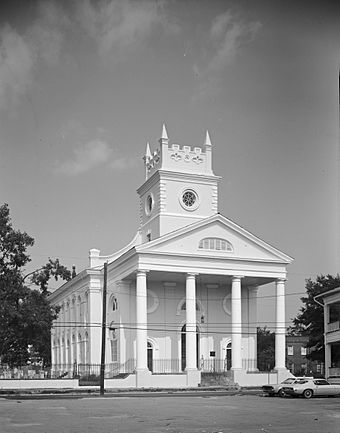Charleston Historic District facts for kids
|
Charleston Historic District
|
|

Cathedral of St. Luke and St. Paul, 126 Coming St.
|
|
| Location | Charleston, South Carolina |
|---|---|
| Architect | multiple, including Robert Mills |
| Architectural style | Greek Revival, Other, Federal |
| NRHP reference No. | 66000964 (original) 70000923 (increase 1) 78002497 (increase 2) 84002028; 85001833; 86000588 (increase 3) |
Quick facts for kids Significant dates |
|
| Added to NRHP | October 15, 1966 |
| Boundary increases | January 30, 1970 July 16, 1978 August 2, 1984 |
| Designated NHLD | October 9, 1960 |
The Charleston Historic District is a very special area in Charleston, South Carolina. It is also known as the Charleston Old and Historic District. This district is so important that it's been named a National Historic Landmark District. This means it's a place recognized by the United States government for its amazing history and buildings.
This historic area covers most of the old part of Charleston. It has many unique buildings from the 1700s and 1800s. You can see many famous "Charleston single houses" here. In 1960, this district was officially named a National Historic Landmark.
Charleston was a leader in protecting its history. In 1931, it created the first historic district in the United States. This district was protected by local laws. This idea later inspired other cities, like New York City, to protect their own historic places.
Contents
Exploring Charleston's Historic Architecture
The city of Charleston was started way back in 1670. Its main historic area was planned in 1680. This was on a piece of land between the Ashley and Cooper Rivers. For hundreds of years, Charleston has been a major trading city.
Because of its long history, the city has many different styles of buildings. These show how the city grew over more than 300 years. One special type of building is the "Charleston single house." These houses are usually only one room deep. They face the street with their short side. The main entrance is often on the long side, leading to a porch. These homes are built from wood, brick, or stucco.
Famous Buildings on Broad Street
Broad Street is a very old and important street in Charleston. It has many beautiful houses from the Federal period. Many of these old homes are now used as shops or offices.
Broad Street is also home to some of Charleston's most important early buildings:
- The St. Michael's Episcopal Church was built in 1752.
- The Exchange building dates back to 1767.
- The Charleston County Courthouse was built in 1792.
How the Historic District Grew
Charleston first created its "Old and Historic District" with local laws. Later, in 1960, a part of this area became a National Historic Landmark District. This was because of its amazing architecture.
When the district was first added to the National Register of Historic Places in 1966, it was a smaller area. It was roughly bordered by Broad, Bay, S. Battery, and Ashley streets. It also included an area along Church Street. Over time, the district was made larger in 1970 and 1978. Now, the National Register district is about the same size as the local historic district. It reaches as far north as Calhoun Street in some places. More buildings were added to the district in 1984, 1985, and 1986.
Images for kids







